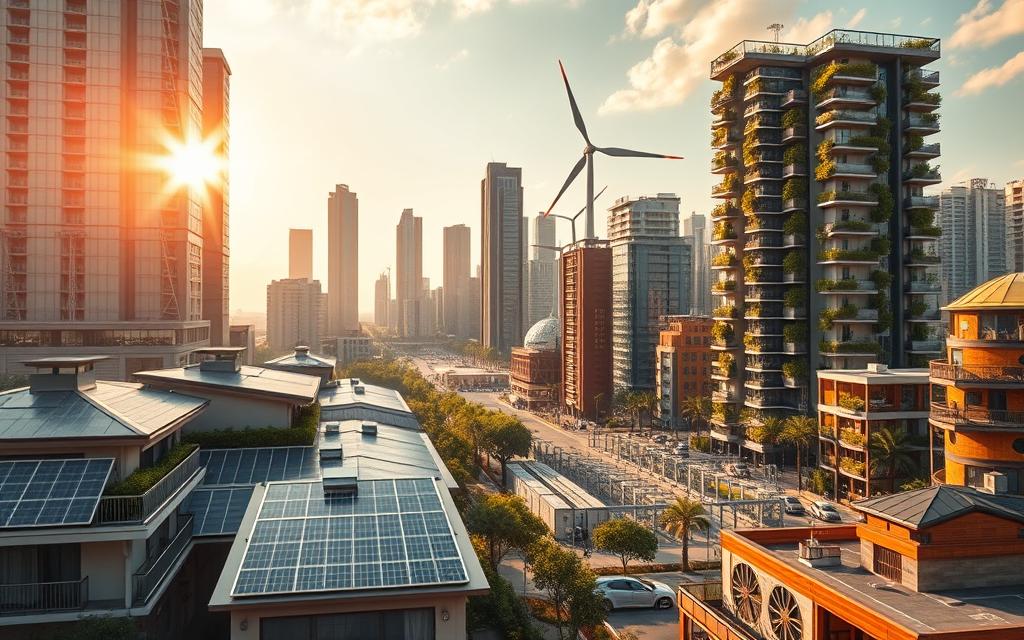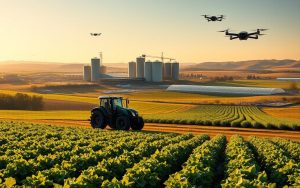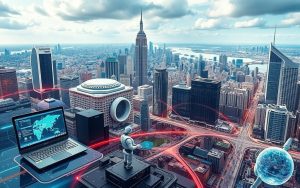While dystopian series like Black Mirror dominate conversations about digital advancement, a quieter revolution has been unfolding. This started in 2006 in London. Paul Miller organised the first hack weekends, where programmers tackled social issues.
This movement laid the groundwork for today’s tech for good philosophy. It showed that digital tools can solve real-world problems without losing ethics.
Today, sustainable innovations have grown a lot. Developers use AI, blockchain, and IoT to create solutions. These solutions help both local communities and global systems. They focus on human-centred design and making a difference, not just making money.
This article looks at four key areas where technology makes a big difference:
• Climate crisis mitigation through smart energy grids
• Medical breakthroughs that make treatment more accessible
• Educational platforms that bridge opportunity gaps
• Equality initiatives powered by data transparency
We’ll see how Miller’s hackathons continue to shape global problem-solving efforts. The shift from garage prototypes to changing society shows technology’s true power. It’s when we use it with conscience, not just convenience.
1. Technological Innovations Addressing Climate Change
Technology is changing how we face environmental challenges. Breakthroughs are speeding up the clean energy transition and tackling big problems. For example, drones are mapping Nepal after an earthquake, and blockchain is tracking food aid worldwide.
1.1 Renewable Energy Breakthroughs
Solar and wind tech is getting a lot better. Perovskite solar cells are now 33% efficient, almost double the old silicon panels. They also cost less to make.
Scotland’s deep waters are testing floating wind turbines. These turbines can catch 40% more wind than traditional ones.
Solar panel efficiency improvements
Oxford PV’s new solar cells are a big step forward. They’re more efficient and cheaper to make. Plans are to install them in California by 2025.
Offshore wind farm innovations
Norway’s Hywind Tampen project is using 88 MW turbines to power oil platforms. This shows how wind power can reach new places. The turbines are designed to handle strong storms.
1.2 Carbon Capture and Storage Systems
Reducing emissions is key, but carbon sequestration tech is also important. Climeworks’ Orca plant in Iceland removes 4,000 tonnes of CO₂ a year. Drax Power Station is also working on capturing emissions, aiming for 8 million tonnes by 2030.
Direct air capture technology
Carbon Engineering’s DAC units can be used anywhere. They’re working with Occidental Petroleum to build a Texas facility. This will remove 1 million tonnes of CO₂ a year.
Bioenergy with carbon capture (BECCS)
Drax’s Yorkshire pilot has shown 94% capture rates. This could offset emissions from 12 million flights. It’s a big step for industries.
1.3 Smart Agriculture Solutions
Agritech solutions are changing how we grow food. John Deere’s 8RX tractors use IoT sensors to save water. Singapore’s Sustenir Agriculture grows kale in 35 days using vertical farms.
Precision farming with IoT sensors
Climate FieldView uses data to make fertiliser plans. Early users have seen 15% more yield with 10% less input.
Vertical farming advancements
AeroFarms in New Jersey grows greens without sunlight. They use 95% less water than field farming. Their AI adjusts nutrients hourly for better growth.
These technologies show that tackling climate change is happening now. They’re making a real difference.
2. Revolutionising Healthcare Through Digital Solutions
The healthcare world is changing fast with new digital tools. These tools, like AI and wearable sensors, are making care better and research easier. They help solve big problems in treating patients, studying genes, and responding to emergencies.
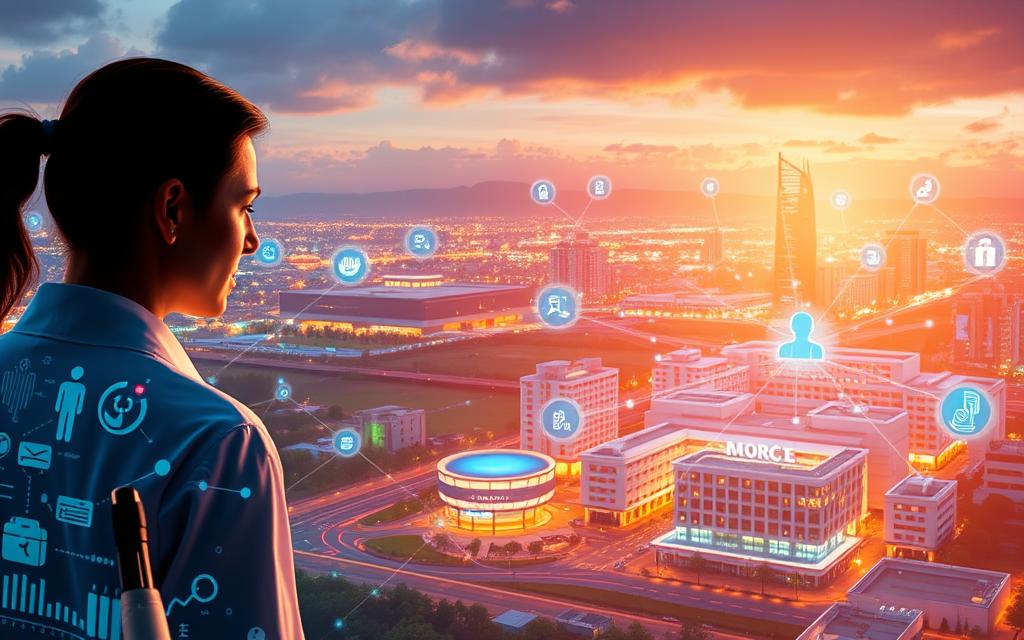
Telemedicine Platforms
Telemedicine has changed how we get medical help. The NHS is testing wearable devices like Abbott’s FreeStyle Libre 3. These devices help keep blood sugar levels in check, cutting hospital visits by 42%.
Remote Patient Monitoring Systems
Wearable tech lets doctors check on patients from afar. Teladoc’s work shows a 35% drop in readmissions for chronic conditions. This tech alerts doctors to any issues quickly, helping them act fast.
AI-Powered Diagnostic Tools
Babylon Health’s AI is as good as human doctors in diagnosing. It looks at symptoms, medical history, and scans fast. This is a big help in areas where doctors are scarce.
Genomic Sequencing Advances
New tech in genomic editing is opening up new treatments. Vertex Pharmaceuticals’ CRISPR treatment for sickle cell disease is showing great promise, with 97% success in early tests.
CRISPR Technology Applications
CRISPR is being used to tackle over 6,000 genetic diseases. A study has shown it can modify stem cells to fight HIV, a big step for treating immunodeficiency diseases.
Personalised Medicine Developments
Oncology teams are now using DNA sequencing to tailor treatments. This has led to a 22% increase in survival rates for metastatic cancer, beating traditional chemotherapy.
Pandemic Response Technologies
The COVID-19 pandemic pushed the development of pandemic tech forward. Moderna’s mRNA vaccine was made in just 63 days. Now, it’s being used to fight mpox and flu too.
Vaccine Development Acceleration
Rwanda’s drone network is delivering vaccines fast, in just 30 minutes. This has boosted childhood vaccination rates by 67% in remote areas.
Contact Tracing Applications
Singapore’s TraceTogether app cut COVID-19 spread by 33%. It uses Bluetooth to alert users of close contacts, handling 10 million data points daily while keeping privacy.
| Technology | Application | Impact |
|---|---|---|
| Wearable Sensors | Chronic Disease Management | 42% Fewer Hospitalisations |
| CRISPR Editing | Genetic Disorders | 97% Treatment Efficacy |
| mRNA Platforms | Vaccine Development | 63-Day Production Cycle |
3. Bridging Educational Gaps with EdTech Advancements
Educational technology is breaking down barriers to learning. It offers solutions that make learning accessible everywhere. From remote villages to cities, digital tools are helping learners who were once left behind. This change is not just about technology; it’s changing how we learn and use knowledge worldwide.
Global Classroom Platforms
MOOCs have made higher education available to all. Platforms like Coursera offer scholarships to refugees, helping 76,000 learners in tough spots. Microsoft has given 12 million teachers tools to teach in new ways, starting in 2020.
Language learning applications
Duolingo is teaching endangered languages, helping preserve cultures. Their Navajo course saw a huge increase in interest after working with indigenous groups. This shows how tech can help keep traditional knowledge alive.
Immersive Learning Technologies
In India, Atal Labs use virtual reality for field trips. Students explore historical sites and ecosystems in a new way. Labster’s VR biology lessons are used in over 2,500 schools, boosting test scores by 28%.
Augmented reality lab simulations
Google’s AR chemistry models let students play with molecules in 3D. Teachers say students learn 40% faster with these tools, which are great for visual learners.
AI-Powered Tutoring Systems
Century Tech’s platform uses AI to create study plans for each student. In UK state schools, this cut achievement gaps by 17% in two years.
Automated assessment tools
In South Korea, AI grading systems check 10,000 essays a day with 92% accuracy. This lets teachers focus on helping each student. These tools also spot knowledge gaps quickly, so teachers can act fast.
| Platform | Accessibility Feature | Impact Metric |
|---|---|---|
| Coursera | Refugee scholarships | 76k+ beneficiaries |
| Duolingo | Endangered languages | 8 languages preserved |
| Labster VR | Biology simulations | 28% score increase |
| Century Tech | Adaptive algorithms | 17% gap reduction |
4. Promoting Global Equality Through Technological Access
Technology can be a great equaliser when used wisely. It helps overcome barriers in both remote areas and cities. This section looks at three key areas where technology is making a difference.
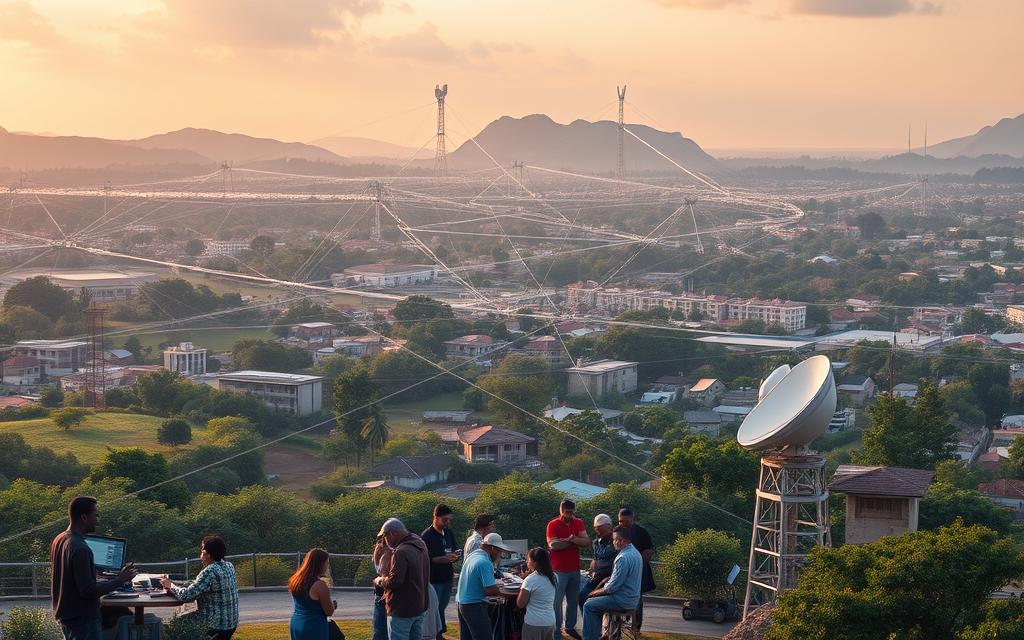
4.1 Internet Connectivity Initiatives
Creating internet access for all is a big challenge. Low Earth orbit satellite networks like SpaceX’s Starlink are making a big impact. They bring fast internet to places that were hard to reach before.
In Northern Kenya, for example, nomads can now get health services and check market prices online. This is thanks to satellite connections that don’t rely on old infrastructure.
Another approach is community mesh networks. These are networks owned by the community. They:
- Don’t rely on big telecom companies
- Let people create content in their own languages
- Help during emergencies by keeping communication lines open
4.2 Blockchain for Social Impact
Blockchain technology is changing how we help others. The UNDP’s Building Blocks project in Jordan uses it to:
- Track aid as it’s given out
- Stop people from getting aid they don’t need
- Save a lot of money on paperwork
Another big change is digital identity solutions. The World Bank’s ID4D programme gives legal IDs to 1.1 billion people. This lets them vote, go to school, and use financial services. But, studies show we need to make sure this data is used right.
4.3 Financial Inclusion Technologies
Mobile banking platforms like Kenya’s M-Pesa are changing banking. They have 51 million users in Africa. These services:
- Let people send small amounts of money instantly
- Don’t need a lot of money to start saving
- Help farmers get insurance for their crops
In the world of decentralised finance, services like BitPesa make sending money cheaper. They cut fees from 7% to 3%. This is a big help for workers sending money back home. As these technologies grow, they challenge old banking ways and raise questions about rules.
5. Conclusion
Technology has a big role in helping achieve sustainable development goals. Innovations like AI in healthcare and blockchain in finance are promising. But, we must tackle issues like algorithmic bias.
Programmes like the Master in Technology & Global Affairs at Geneva’s Graduate Institute help. They teach policymakers to balance innovation with responsibility.
Projects like Kyrgyzstan’s Naryn Project show how tech can help communities. It uses solar power to connect remote areas, improving education and the economy. This shows that tech works best when it’s community-focused.
Educational systems need to change to produce tech-ethics leaders. Courses in data governance and impact assessment are key. They help professionals think about the long-term effects of new tech.
The future needs teamwork between tech experts, lawmakers, and civil society. By making ethics a part of tech design and policy, we can create positive change. As we face climate issues and more people get online, responsible innovation is essential for all.

